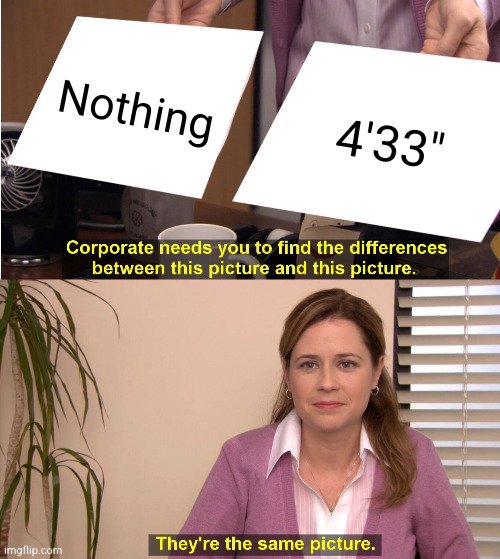Fermion
Salary also can't be exempt from overtime if the salary works out to less than minimum wage for the hours worked. So only 2080 of the 6000 hours could be minimum wage and the other 3920 would be paid at time and a half.
They haven't been working on and off a couple weeks for me as well.
Why do you perforate the crust with a fork?

I see you've already been told what 4'33" is but I thought I would point out that we are in complete agreement.
4'33" by John Cage would be an acceptable addition to this playlist.
Isn't this a textbook candidate for a class action suit?
The original post gives 12 month forward looking P/E. You linked a 10 year moving average backward looking P/E. So the main difference is in what time period the figure looks at, not in being inflation adjusted.
Are you familiar with the difference between polar (r, theta) coordinates and cartesian (x,y) coordinates? Parabolas are the solution to gravity that is uniform no matter where you sample. It assumes that gravity points in the same direction with the same magnitude no matter where you are. In this model, gravitational acceleration is always 9.81 m/s^2 in the -y direction. That is a reasonable simplification for things that are at the human scale constrained to near the earth's surface. Deviations from air resistance will matter far more than errors stemming from that assumption anyway.
Conic sections are the solutions to gravity that is between two objects where the force is along the line between the center of mass of both objects and the strength is inversely proportional to the square of separation. Now you need polar cpordinates and the direction of gravity changes as things move around. This works pretty well for orbits around the earth and orbits around the sun, because the earth is so much more massive than sattelites that orbit it, and the sun is so much more massive than things that orbit it. If you need really precise orbit trajectories, ellipses aren't truly accurate either. You need to account for all the orbiting bodies in the system. The 3-body problem famously doesn't have purely analytical solutions, and you need to resort to numerical methods to calculate trajectories.
So both solutions come from simplified mathematical models. Despite being simplifications, their predictive power is actually very goood. However, like you are intuiting, it's important to know when those simplifying assumptions lead to errors that start to become important. It's hard to come up with a particular threshold for when you need to switch from one model to another, because it really depends on how much accuracy your application needs.
Radon should be yellow. You don't want long term exposure of it in your lungs, but it's still mostly chemically inert and not a significant immediate danger.
I know they don't like to read long bills, but maybe one of their interns can read Matthew 6:1-8 to them.
I did search for "weather on the way" in google play store. While they don't have an android app, I found two similar apps that do a lot of what I wanted: "drive weather" and "highway weather." Thank you for the search term that yielded results. I like that the"highway weather" app allows adding in rest stops and propagates the change into the forecast.
I will note that neither of these options seem to offer turn by turn navigation. So there is still room for some of the navigation apps to integrate this functionality.